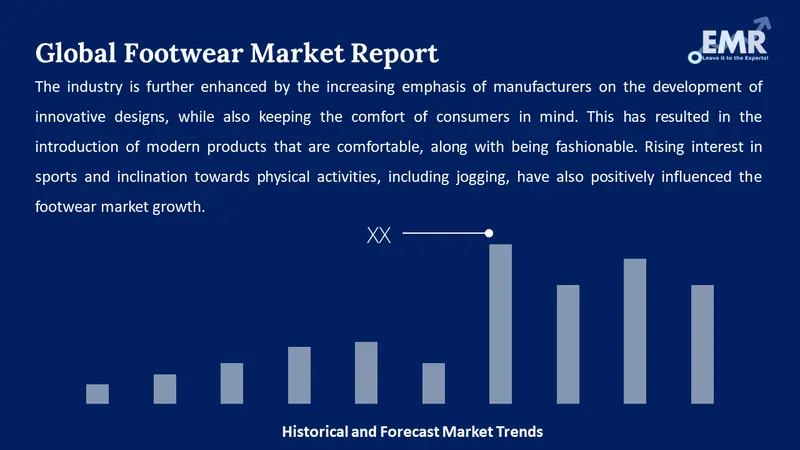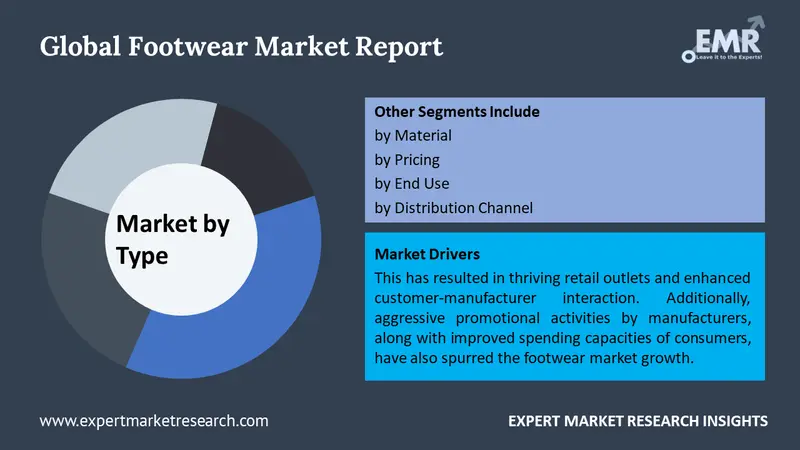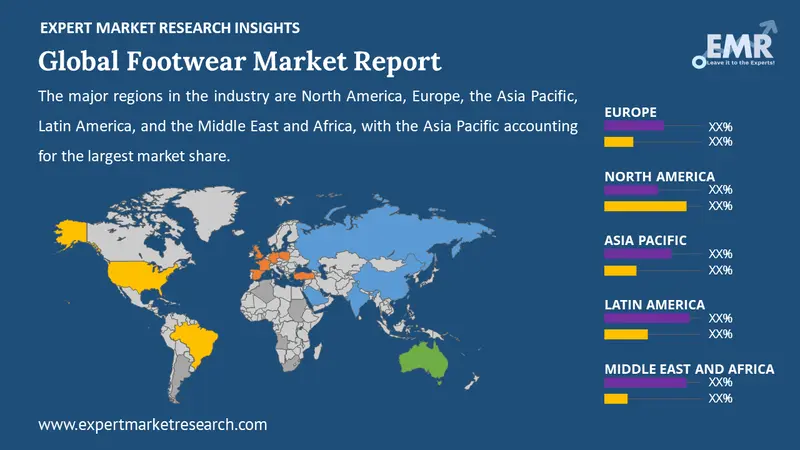

The global footwear market reached a value of around USD 417.50 billion in the year 2023. The market is assessed to grow at a CAGR of 4.9% between 2024 and 2032 to reach a value of approximately USD 642.16 billion by 2032.
| Global Footwear Market Report Summary | Description | Value |
| Base Year | USD Billion | 2023 |
| Historical period | USD Billion | 2018-2023 |
| Forecast Period | USD Billion | 2024-2032 |
| Market Size 2023 | USD Billion | 417.5 |
| Market Size 2032 | USD Billion | 642.2 |
| CAGR 2018-2023 | Percentage | XX% |
| CAGR 2024-2032 | Percentage | 4.9% |
| CAGR 2024-2032 - Market by Region | Asia Pacific | 6.2% |
| CAGR 2024-2032 - Market by Country | China | 6.6% |
| CAGR 2024-2032 - Market by Country | Brazil | 5.6% |
| CAGR 2024-2032 - Market by Type | Athletic | 5.3% |
| CAGR 2024-2032 - Market by End Use | Women | 5.4% |
| Market Share by Country | Japan | 6.1% |

Read more about this report - REQUEST FREE SAMPLE COPY IN PDF
Footwear consists of an upper section, outsole, and midsole, and in the case of a shoe, it also consists of a heel counter and a tow box. These garments typically serve the purpose of protection against harsh environments and provide stability on slippery surfaces.
The global footwear industry is being driven by the rising demand for superior quality footwear, in conjunction with product innovations and premiumisation. In addition to this, the market is further being fuelled by the increasing emphasis of manufacturers on the development of innovative designs, while also keeping the comfort of consumers in mind. This has resulted in the introduction of modern products that provide high performance while being comfortable and fashionable.
Increasing emphasis on health and wellness; growing integration of 3D printing technology; rising popularity of e-commerce platforms; and the rising importance of sustainability are positively impacting the footwear market expansion.
| Date | Company | News |
| Feb 6th 2024 | Reebok | Collaborated with WHR, updating the Club C 85 and Beatnik models with a beach utility look, utilising recycled fabrics and suede for durability and sustainability. |
| Feb 5th 2024 | InventHelp | Invented Low Blow, a shoe that can adjust to the growing feet of children. |
| Feb 1st 2024 | Lululemon | Announced the launch of its new casual and performance-oriented footwear for spring and summer, including the launch of the men’s collection. |
| May 4th 2023 | FitFlop | Inaugurated two exclusive brand stores in Ahmedabad and Coimbatore after the successful launch in Chennai and Mumbai. |
| Market Trend | Description |
| Increasing focus on health and wellness | The growth of the footwear market has surged in the past few years owing to the rising awareness about health and wellness. |
| Growing emphasis on sustainability in the fashion industry | The development of vegan footwear is expected to be a major factor propelling the market as manufacturers increasingly focus on adopting eco-friendly materials. |
| Integration of advanced technologies for customisation needs | There is a growing consumer demand for personalised and custom-designed footwear, facilitated by the increasing integration of 3D printing technologies. |
| Rising popularity of e-commerce platforms | The market is witnessing significant growth through online sales, driven by convenience, a wider selection, and innovative delivery services such as one-day delivery. |
The global market for footwear is primarily being driven by the increasing popularity of e-commerce platforms, such as Amazon, Walmart, and Alibaba, among others. Customers are increasingly shifting towards online shopping owing to its convenience and the availability of diverse products. This development is further supported by the expansion and fortification of regional and global logistics.
| CAGR 2024-2032 - Market by | Country |
| China | 6.6% |
| Brazil | 5.6% |
| Australia | 4.7% |
| UK | 4.5% |
| Canada | 4.4% |
| USA | XX% |
| Germany | XX% |
| France | 4.1% |
| Italy | XX% |
| Japan | XX% |
| India | XX% |
| Saudi Arabia | XX% |
| Mexico | XX% |
The sneaker market is expected to be a major influencing factor propelling the footwear demand. The market for sneaker is expected to develop rapidly in the forecast period owing to the availability of sneaker-specific platforms, including StockX, GOAT, and Grailed, among others.
Recycling is another major factor influencing the market as it aligns with rising manufacturers’ focus on sustainability. Companies are investing in innovative recycling technologies that allow the repurposing of various materials into new footwear. For example, thermoplastic polyurethane (TPU) can be recycled to create performance-grade materials for shoes.
Adidas, a leading footwear player, has established a longstanding partnership with Parley for the Oceans to create shoes made from upcycled marine plastic waste. The initiative not only addresses the issue of ocean plastic but also showcases how recycled materials can be integrated into high-performance footwear.
Trends in the Export and Import of Footwear
The import and exports trends for footwear with outer soles of rubber, plastics, leather, or composition leather and uppers of various materials, based on data from the International Trade Centre (ITC) Trade Map from 2019 to 2023 indicate economic impacts and market adjustments over these years.
In 2023, the global exports of footwear with outer soles of rubber, plastics, leather, or composition leather was valued at approximately USD 49.53 billion. Vietnam led the global exports rising from USD 12.04 billion in 2022 to USD 13.27 billion in 2023. China followed with USD 12.60 billion in 2023, showcasing its strong manufacturing base. Belgium's exports amounted to USD 3.37 billion, while Germany and Italy reported USD 3.04 billion and USD 2.75 billion respectively. The upward trend in export values from 2019 to 2023 reflects increasing global demand and production capacity, particularly in Asia and Europe. This data indicates robust growth and competitive dynamics in the global footwear market.
In 2019, the global import value was USD 44.86 billion. This decreased to USD 38.96 billion in 2020, largely due to the COVID-19 pandemic. The market rebounded in 2021 to USD 45.13 billion and peaked at USD 54.39 billion in 2022. By 2023, the value stabilized at USD 45.79 billion, indicating a possible market adjustment post-pandemic. The United States remained the largest importer, with USD 9.24 billion in 2019, dropping to USD 7.14 billion in 2020, then recovering to USD 9.44 billion in 2021. In 2022, imports surged to USD 12.52 billion before declining to USD 7.56 billion in 2023, reflecting market volatility and adjustments.
| Market Share by | Country |
| Japan | 6.1% |
| USA | XX% |
| Canada | XX% |
| UK | XX% |
As per the footwear industry statistics, in the European region, Germany, France, and Italy showed varied but generally positive trends. Germany's imports were stable, starting at USD 3.90 billion in 2019, slightly increasing to USD 3.94 billion in 2020, and peaking at USD 4.89 billion in 2022 before decreasing to USD 3.76 billion in 2023. France exhibited a similar pattern, with USD 2.51 billion in 2019, a slight dip in 2020, followed by a rise to USD 3.15 billion in 2022 and a stabilization at USD 3.00 billion in 2023.
China's import values displayed consistent growth, from USD 2.09 billion in 2019 to USD 2.17 billion in 2022, before slightly dropping to USD 2.01 billion in 2023, indicating strong domestic market share of footwear industry. Spain's imports rose from USD 1.32 billion in 2019 to USD 1.83 billion in 2023. Japan's imports reflected moderate growth, from USD 2.15 billion in 2019 to USD 1.92 billion in 2022, stabilizing at USD 1.76 billion in 2023. The United Kingdom saw a steady increase from USD 2.21 billion in 2019 to USD 2.15 billion in 2022, slightly adjusting to USD 1.66 billion in 2023. The Netherlands' imports showed resilience, growing from USD1.41 billion in 2019 to USD1.6 billion in 2022, then decreasing to USD1.63 billion in 2023.
Based on footwear industry trends, the global e-commerce is anticipated to achieve a compound annual growth rate (CAGR) of 9% through 2027, significantly outpacing the projected 4% growth rate for brick-and-mortar retail. In 2022, e-commerce sales rose by 3% in Europe and 7% in both the US and Asia.

Read more about this report - REQUEST FREE SAMPLE COPY IN PDF
“Global Footwear Market Report and Forecast 2024-2032” offers a detailed analysis of the market based on the following segments:
| Market Breakup | Categories |
| Type | Non-Athletic Footwear, Athletic Footwear |
| Material | Rubber, Leather, Plastic, Fabric, Others |
| Pricing | Premium, Mass |
| End Use | Men, Women, Kids |
| Distribution Channel | Supermarket and Hypermarkets, Footwear Specialists, Departmental Stores, Clothing Stores, Online, Others |
| Region | North America, Europe, Asia Pacific, Latin America, Middle East and Africa |
Non-athletic footwear can be further classified based on type into sneakers, shoes, boots, slippers, and sandals.
| CAGR 2024-2032 - Market by | Type |
| Athletic | 5.3% |
| Non-Athletic | XX% |
The demand for athletic footwear is significantly surging, fuelled by innovations in designs and materials
Athletic footwear is witnessing an increase in demand owing to the rapid innovations in materials and designs, allowing improved performance and comfort. The need for sports shoes utilised in activities such as running, gym, cycling, football, and cricket, among others, is propelled by the rising inclination of people to participate in such sports.
Furthermore, growing health consciousness and increasing participation in indoor and outdoor physical exercises further propel the athletic footwear market expansion. Meanwhile, the non-athletic segment is likely to cover a major portion of the market as it consists of a wide variety of footwear, including flats, loafers, and sneakers, among others. Some major factors aiding the segment’s growth include the rise in the number of working professionals and growing fashion consciousness among consumers.
| CAGR 2024-2032 - Market by | End Use |
| Women | 5.4% |
| Men | 4.7% |
| Kids | XX% |
Men are likely to contribute to a major portion of the global footwear market share in the coming years
With men being more inclined towards outdoor sports activities, such as golf, football, cricket, hiking, and other activities, they are expected to increase the overall footwear market value. Moreover, the sneaker culture, which includes collecting rare and exclusive sneakers, has a considerable male following. This enthusiasm not only boosts sales of high-end sneakers but also influences trends and demand in the broader market for footwear.
Meanwhile, women's footwear is expected to grow at a rapid rate owing to continuous innovations, the launch of new product lines, and collaborations. For instance, Lululemon launched its women-focused footwear line in 2022, introducing four styles including the Blissfeel running shoe, available from March 22 in select markets.
Some of the major players in the market are increasingly innovating with materials to launch high-performance footwear:
| Company | Product Range | Headquarters | Founded |
| Nike, Inc. | Athletic footwear, apparel, equipment, and accessories | Oregon, United States | 1964 |
| PUMA SE | Athletic and casual footwear, apparel, and accessories | Herzogenaurach, Germany | 1948 |
| Skechers USA, Inc. | Lifestyle and performance apparel and footwear | California, United States | 1992 |
| Adidas AG | Performance and lifestyle footwear, apparel, and accessories | Herzogenaurach, Germany | 1949 |
Other key players in the global footwear market are VF Corporation, TBL Licensing LLC, Crocs Retail, LLC, Under Armour®, Inc., Jimmy Choo S.r.l., FILA Holdings Corp., Prada S.p.A., Burberry Group Plc, Wolverine World Wide, Inc, and Bata Corporation, among others.
Manufacturers in the market are continuously involved in research and development to improve the comfort and performance of footwear. Some notable innovations in the material include the waterproof Gore-Tex, carbon fibre, and Kevlar sole, which is known for its strength and heat resistance.
Moreover, the integration of advanced technologies in the manufacturing process has become a significant factor propelling the market growth. For instance, 3D printing has enabled companies to provide a wide range of customisation options and manufacture custom footwear that can fit the user’s feet perfectly.

Read more about this report - REQUEST FREE SAMPLE COPY IN PDF
The market in the Asia Pacific is likely to be a major contributor to the growth of the footwear industry in the coming years. This growth is attributed to the region's dynamic role in the market, which is notably labour-intensive and influenced by several critical factors including land resources, labour costs, material availability, environmental considerations, and the sales market landscape. The shift of global footwear manufacturing bases to the Asia Pacific region is a strategic move by major consumer markets, manufacturers, wholesalers, and retailers aiming at profit maximisation.
| CAGR 2024-2032 - Market by | Region |
| Asia Pacific | 6.2% |
| Middle East and Africa | 5.4% |
| Latin America | 5.1% |
| North America | 4.2% |
| Europe | 4.0% |
These trends in footwear industry capitalise on the lower production costs available in countries within this region. Notably, Japan, Taiwan, India, and China have become highly attractive markets for footwear production and consumption, driven by their economic growth.
Meanwhile, North America and Europe are likely to maintain a strong base in the market as the developed economy and increasing disposable income enable the high sales of a wide variety of footwear products.
As per the footwear industry analysis, the growing popularity of sports, such as basketball, football, and rugby, is expected to be a major factor in propelling the demand for high-performance and premium footwear. Major companies are also introducing special edition products in collaboration with top athletes to reach the fans of the sport and particular athletes.
Historical and Forecast Trends, Industry Drivers and Constraints, Historical and Forecast Market Analysis by Segment: